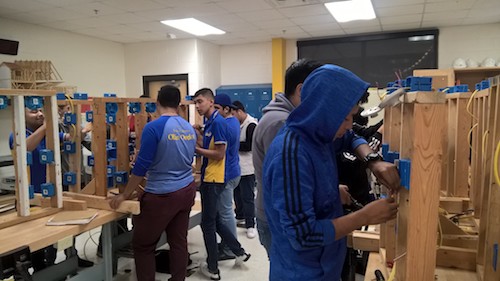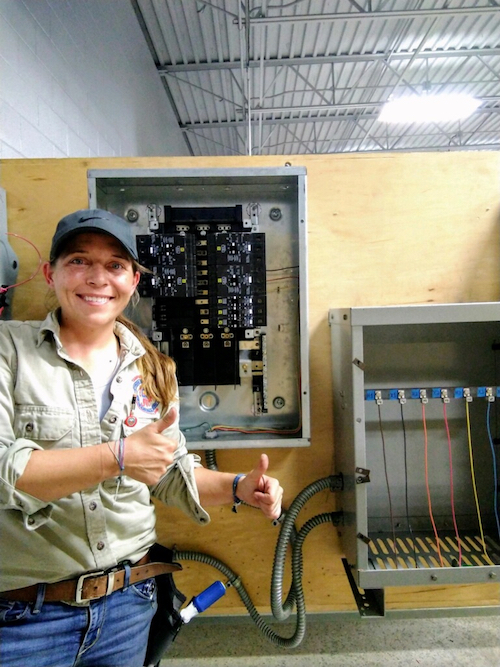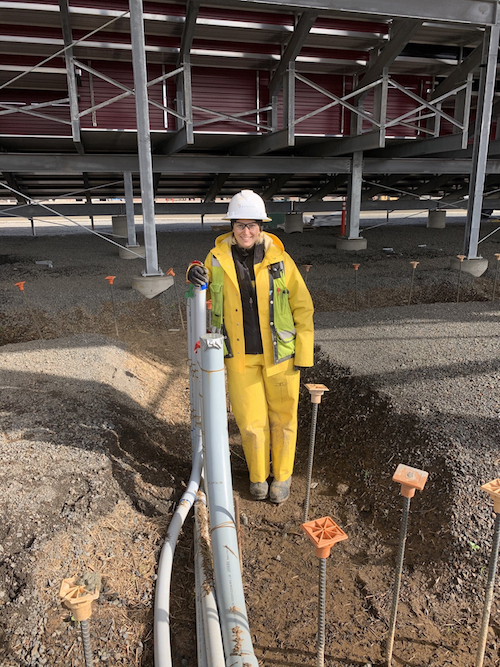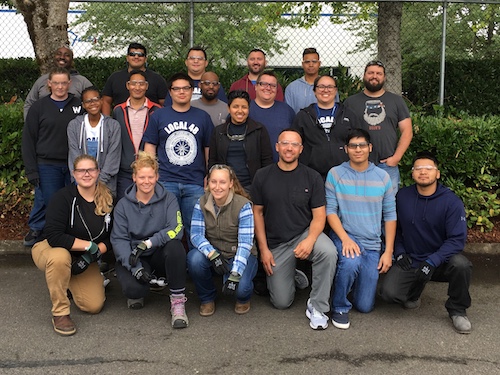Any IBEW member knows a career in the trades can be
incredibly rewarding. Whether it’s a debt-free education, a paycheck that
provides a family with a solid middle-class life or the simple satisfaction of
creating something with your own two hands, the opportunities available through
the IBEW and other union trades are limitless.

|
| Valley View High School students in Hidalgo, Texas get hands-on training through a pre-apprenticeship program started by Weslaco Local 1015 and the Rio Grande Valley Laredo Electrical JATC.
|
But what happens to the millions of Americans and Canadians who don’t know about the trades?
When Henry Miller and the other founding members of this union tasked us with organizing “all workers in the entire electrical industry,” they didn’t mean only those who were lucky enough to have heard of the IBEW.
“I was working in the produce department of a grocery store when I first learned about the IBEW,” said International President Lonnie R. Stephenson. “I didn’t have any family or friends in the union, or even working in the construction industry at the time. But I met an electrician named Ray Wells who came into the store on a service call, and that conversation changed my life.
“As president, I’ve met so many members across North America with similar stories of chance encounters that opened the world of the IBEW to them. And as we continue to work to grow this union and capture even more work, we need to look at ways to take that element of chance out of the equation and make sure every person – especially young people – know there are opportunities for long, fulfilling careers in the trades.”
At local unions and IBEW/NECA training centers across the U.S. and Canada, pre-apprenticeship programs are a proven way of expanding access to the IBEW and extending the hand of opportunity beyond traditional demographic and regional borders.
The introductory courses last between a few weeks and a few months, depending on the program, and are designed to help those interested in a full apprenticeship enter the trades with the skills and knowledge they need. Not only do the programs offer a less intensive way to try out the craft to see if it’s a good fit, they offer classes like math tailored to the trade as well as supervised on-the-job training. Many programs offer direct entry into an apprenticeship upon successful completion.
“These programs give people without any experience in the construction industry the preparation they need to succeed in our training programs,” said Director of Civic and Community Engagement Tarn Goelling. “Apprentices who know what they’re getting into are more successful than those who come in without that information. And these pre-apprenticeships are also an excellent recruiting tool for attracting a more diverse and local pool of candidates.”
Expanding Access
With construction booming in many parts of North America and baby boomers retiring, the demand for more skilled tradespeople is skyrocketing. If ever there was a time to recruit and retain as many people as possible, it’s now. But how do you get into an electrical apprenticeship if you’ve never been told how?

|
| Tampa, Fla., Local 915 member Christy Handley completed her pre-apprenticeship and then topped out as a journeyman wireman in December.
|
For Tom Bowes, a Detroit Local 58 member and assistant director of the Detroit Joint Electrical Apprenticeship Center, his entry into the IBEW, like Stephenson’s, very easily could have not happened. He learned of the union and its apprenticeship through an encounter at the gas station he was working in at the time.
“In 1977, had I not been in that gas station at that specific time, I wouldn’t have learned about Local 58, and I likely would not have had the 41-year career I’ve had with IBEW,” Bowes said. “We want to take the randomness out of it.”
And even if you do find out about the IBEW, you still need to find out if the job is something you want to make a career. Pre-apprenticeships provide those opportunities in a low-risk setting and avoid locals expending valuable training resources on apprentices who discover too late that the construction trades aren’t for them.
The Electrical Training Alliance, the body that provides curriculum and other support to IBEW training centers, is in its fourth year of a five-year grant from the Department of Labor. Over a thousand people have started its pre-apprenticeship program, with about 600 graduating so far from 15 different joint apprenticeship and training committees across the country.
“We’ve been trying for years to get more women and people of color, as well as other underrepresented groups in the trades,” said ETA Director Steve Anderson, who oversees pre-apprenticeships. “The grant has been a great opportunity for that.”
Women currently account for roughly 3% of the construction workforce, with people of color also underrepresented. And unlike typically woman-dominated fields like childcare, construction offers a livable wage and solid benefits. Additionally, according to Jobs with Justice, trades jobs come with a much smaller gender pay gap, just 8.7% compared to the average of 20%. And thanks to the unionization of the industry – and prevailing wage laws – the racial wage gap is also smaller.
If you want to get more women and people of color in the door, you need to think about where you’re advertising, according to leaders at Boston Local 103 and Vancouver, British Columbia, Local 213, who have been reaching out to historically marginalized communities for years.
Local 213’s Director of Programs, Farid Poursoltani, said that typically when they would advertise, about 97% of respondents would be men. With help from a government grant a few years back, they ran the local’s first digital campaign, with ads on social media and Google, directed to women and indigenous groups – in part by including images of those groups. The local has a goal of 20% women by 2021, but Poursoltani says he’d like to hit 30%.
“‘We say we want more women and diversity, but we’re not always doing the work of being inclusive,” Poursoltani said. “We need to be asking how we can be better allies.”
Local 213 also led a pilot program, partnering with Access Trades, to recruit and train aboriginal youth in the province. The Alternate Pathways to Electrical Careers program was designed to bridge the gap between the amount of math, science and English needed for an apprenticeship and what most students were actually exposed to. It graduated 14 students from its inaugural class in 2017 and currently has 35 indigenous apprentices in its system, Poursoltani said.
One state where the number of women in construction is higher than the national average is also home to one of ETA’s most successful programs: Oregon. Portland Local 48 apprentice Suzanne Jaszcult completed the NECA-IBEW pre-apprenticeship program last summer. It’s a 10-week program where the first eight combine classroom learning and lab times. Students learn how to build circuits, bend conduit and get practice with various hand tools. The last two weeks are spent on a jobsite training as apprentices. Perhaps just as important, the program is designed specifically to get historically marginalized groups in.
“The fact that the pre-apprenticeship is specifically designed to recruit women and people of color gave me more confidence that I would be welcome. It sends a ‘we want you here’ sort of message, which was really encouraging,” Jaszcult said. “For people whose identities are underrepresented, this ‘invitation’ is so important.”
Preparing for Success

|
| Portland, Ore., Local 48 apprentice Suzanne Jaszcult completed the NECA/IBEW pre-apprenticeship program last summer.
|
Beyond that welcome message, pre-apprenticeships foster an atmosphere of equality with programs that help to truly and concretely level the playing field. For a lot of women, this means childcare that meets your construction site hours, something that Mississippi’s Women in Construction program offers for its pre-apprentices.
“Childcare is a huge part,” said Ruth Mazara, the program’s operations director. “It helps us to be able to train more women, and the majority want to do electrical work.”
The Women in Construction program, which works with Gulfport, Miss., Local 903, also offers supplemental curriculum like financial planning, résumé writing, and mental health assistance if it’s needed.
“We’re looking at the whole person,” Mazara said.
Washington, D.C.’s Building Futures program works with men and women, some of who are coming out of prison. As such, they also provide a lot of wrap-around services, like ensuring participants have the proper identification.
“I see my job as creating a bridge and being a translator,” said Building Futures Project Manager Emma Brennan.
As Brennan notes, sometimes the services needed are as simple as having the right sized safety equipment. But the programs also provide a space for much-needed relationships to develop.
“Having a pre-apprenticeship changes the face of construction,” Brennan said. “Graduates are more successful and part of that, I think, is because of the friendships women create with other women in the trade. These are lifelong bonds.”
It’s clear there are large, untapped markets of people who would love the chance to get in; they just need a little help getting in the door. And as Local 103 Business Agent Kenell Broomstein noted, seeing people who look like you makes a big difference.
“Representation does matter,” Broomstein said. “Back when I first started 15 years ago, I was the only one who looked like me and it’s important for people to able to see themselves on a job site or wherever, so they know there’s a place for them.”
If Detroit Local 58’s Felicia Wiseman and her son are any indication, the future of the IBEW is indeed bright and more diverse. Her son will top out in June, making him a second-generation member.
“He came through with me. We went to the parades and picnics, all that,” Wiseman said. “Everybody knew him.”
Wiseman teaches at Randolph Career and Technical Center in the city.
“Inner city kids don’t know about trades,” said Wiseman, a 20-year inside wireman. “They haven’t been exposed to much and because of that we have to reach out.”
Wiseman echoed the all-too-common refrains of students not getting enough math while also getting too much emphasis on attending college as the only way to a middle-class life. As a graduate of the University of Michigan, she knows first-hand.
“I would put my IBEW apprenticeship up against my University of Michigan education any day,” Wiseman said.
Pre-apprenticeships also succeed in keeping eventual apprentices in the program. By giving pre-apprentices a chance to try out a trade in a 10-week program, fewer people quit the apprenticeship itself, opening up spaces for more people who truly want to pursue a career in the electrical trade.
“I think it has a huge impact on cutting down on the drop-out rate,” said Mike Richard, the IBEW’s Construction and Maintenance Department director. “It’s one of the biggest bonuses.”
ETA’s Anderson says they are still collecting data on their DOL program, so it’s too early to say definitively that pre-apprenticeships improve retention in full-fledged apprenticeships, but there are some positive signs.
The program in Tampa, Fla., just graduated its first apprenticeship class with former pre-apprentices enrolled. They started with 19 and 12 completed the apprenticeship. JATC Director David McCraw says retention has been roughly the same with each of the four cohorts they’ve had since.
Richard said that Local 58, his home local, has had 75 pre-apprentices so far, with 50 completing the 10-week program. Of those, 40 applied to the full apprenticeship and all are currently enrolled.
Mentoring

|
| Pre-apprenticeship programs across the U.S. and Canada are working to diversify the trades and bring in groups that have historically been marginalized. Pictured: students from Portland, Ore., Local 48.
|
For many new apprentices without a family history in the IBEW or unions, there’s an entire culture and language that can seem foreign. Pre-apprenticeships, coupled with mentoring programs, can help those new to the trades to acclimate – or even those who aren’t so new.
“I’m a legacy; my dad was journeyman wireman. But having a mentor was still beneficial to me,” said Senior Executive Assistant to the International Secretary-Treasurer Darrin Golden of his time as an apprentice at Rockford, Ill., Local 364. “It was nice to have somebody to chat with.”
Golden noted the culture inherent in the trades – and in the IBEW – that is often lost on those outside the union. It’s the jargon, how members to speak to one another, and all kinds of unspoken rules.
“It’s more than just the tricks of the trade, it’s how we speak and relate to each other,” Golden said.
Beyond just teaching the basics like reading a tape measure, Wiseman and other pre-apprentice instructors are also giving the students something deeper and more personal.
“They see that you care,” Wiseman said. “It’s a morale thing. They know that somebody is backing them.”
A 2016 note from Christy Handley, then a pre-apprentice, to Tampa, Fla., Local 915’s Theresa King may sum it up best. King is the first woman president of Florida’s Building and Construction Trades Council.
“I wanted to thank you for taking the time to visit our pre-apprenticeship class last Friday. You are truly an inspiration for women in the electrical industry. I've wondered if my gender would limit my advancement opportunities as my career progresses and you are living proof that the sky is the limit,” Handley wrote.
Handley topped out as a journeyman wireman at Local 915 in December. “That pre-apprenticeship was one of the best things that could have happened to me,” she said. “I’m forever grateful for the opportunity.”